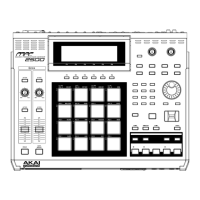MPC2500 Operator’s Manual rev 1.0
49
Chapter 9 : Q-Link slider & knob
By using the Q-Link sliders and knobs, you
can control certain pad parameters (filter,
tune, etc…) with a slider or knob. There
are two ways (NOTE ON and REALTIME)
for controlling the sound by Q-Link.
NOTE ON, the sound will be affected to
the position of Q-LINK slider/knobs at the
point the Pad is hit. But the sound will not
be affected by changing the Q-Link slider/
knobs after hitting the pad. REALTIME,
you can change the sound during playing
back by changing the Q-LINK slider/knob.
In this section, you will learn how to set the Q-Link sliders
or knobs. This is done in the SLIDER mode, which can be
accessed by pressing the [MODE] key and then the [PAD 1]
(SLIDER) key. The SLIDER mode has 4 pages, [F1] (Q1),
[F2] (Q2), [F3] (Q3), and [F4] (Q4), and you can set the Q-
Link slider 1 and 2, Q-Link knob 3 and 4 separately.
Setting the slider & knob
01. In the Assign pad field, select the pad to which you
wish to assign Q-Link by hitting it.
The effect of the slider or knob will be applied to
the selected pad. If you do not wish to use the Q-
Link function for any pad, select OFF by turning
the DATA wheel.
02. In the Change field, select the condition for changing
the parameter.
NOTE ON : The setting value of the Q-LINK
slider/knob at hitting the pad af-
fects to the sound. If you change the
Q-LINK slider/knob while the
sound is playing back, the sound
will not be changed. The informa-
tion of the slider or knob position
will be sent to the sampler section
as Note Variation data The Note
Variation data is included in the
Pad Event and converts the specific
parameter value to slider or knob
position data. For example, when
you select TUNE as a parameter, by
moving the slider, you can affect the
sample tune.
REAL TIME :
If you change the Q-LINK slider/
knob while the sound is playing
backs, the sound will be changed.
When REAL TIME is selected, the
information of Q-LINK slider/knob
is recorded as a Q-LINK event , not
as Note Variation data.
03. In the Parameter field, select the parameter you wish
to control.
•
When the REAL TIME is selected in the Change field
TUNE : This controls the sample’s pitch.
LEVEL : This controls the sample’s volume level.
CUTOFF1+2 : This controls the cutoff frequency of both Fil-
ter 1 and Filter 2.
CUTOFF1 : This controls the cutoff frequency of Filter 1.
CUTOFF2 : This controls the cutoff frequency of Filter 2.
RESO1+2 : This controls the resonance value of both Fil-
ter 1 and Filter 2.
RESO1 : This controls the resonance value of Filter 1.
RESO2 : This controls the resonance value of Filter 2.
PAN : This control the sample’s pan position.
•
When the NOTE ON is selected in the Change field
TUNE :
This controls the sample’s pitch.
Filter :
This controls the cutoff frequency Filter.
LAYER :
This allows you to alter the HIGH and
LOW Range at which the Event will be
triggered.
ATTACK :
This controls the attack time of the
Amp Envelop.
DECAY :
This controls the decay time of the
Amp Envelope.

